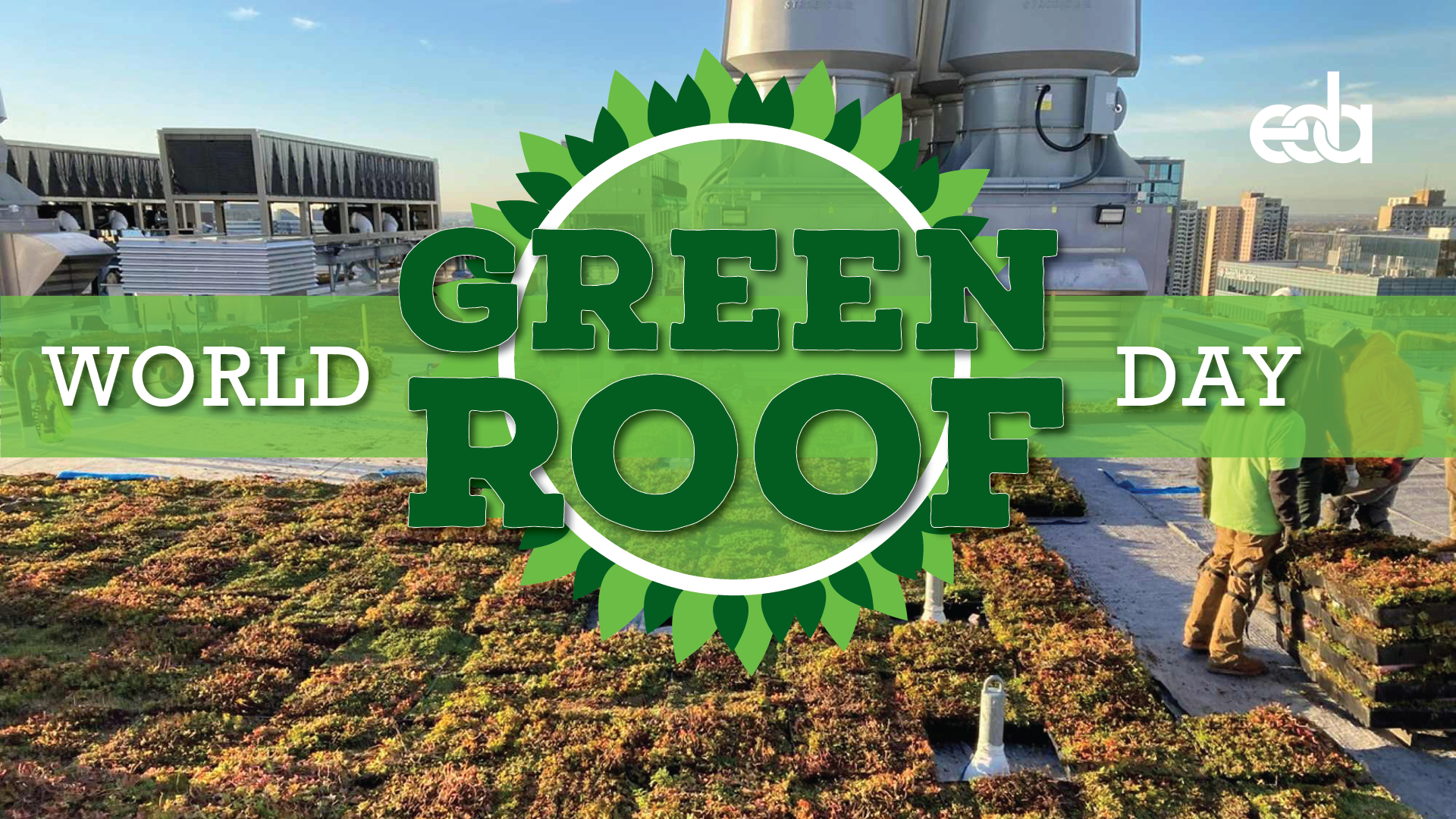World Green Roof Day is an annual celebration on June 6 to appreciate the beauty and innovation of green roofs and their contribution to a sustainable future. Green roofs have been growing in popularity due to their important role in mitigating the effects of climate change, among many other benefits. Today, we are excited to examine the benefits of green roof systems and how they combat key environmental concerns.
What is a Green Roof?
Green roof systems, also known as vegetated roofs or living roofs, are landscaped roofs using specifically designed soil and plantings. Installing them involves layering a waterproof membrane, root barrier, drainage system, growing medium, and vegetation on top of a traditional roof. Some of the benefits of green roofs include stormwater management, energy savings, improved air quality, increased biodiversity, and aesthetic appeal. Additionally, green roofs also help reduce the urban heat island effect.
Urban Heat Island Effect
Cities and urban areas are generally significantly warmer than rural areas due to the urban heat island effect. This effect is caused when there is a dense collection of buildings that absorb and retain heat. The prevalence of heat-absorbing surfaces such as asphalt and concrete used on traditional roofs causes urban areas to trap heat. This ultimately leads to higher temperatures, increased energy consumption, risks of heat-related illness, and air pollution. Green roofs however, offer an innovative solution to mitigate the effects of urban heat islands. These systems reduce heat absorption and offer an extra level of protection to extend the lifespan of your roof.
How Green Roofs Combat Heat
1. Thermal Insulation
Green roofs provide an additional layer of insulation on top of buildings. The soil helps to insulate the building as it provides a barrier between the outside environment and the building's interior, slowing the transfer of heat. The insulation effect is beneficial in both summer and winter as it helps keep the building cooler in the summer and warmer in the winter. The vegetation on the systems also provides shade for the roof, reducing the amount of direct sunlight reaching the building's surface.
2. Evapotranspiration
Evapotranspiration is a process in which plants absorb water through their roots and release it as water vapor through their leaves. Green roofs perform this process by using the heat in the air to evaporate the water collected by the plants and soil. This process produces a cooling effect as the moisture from the evapotranspiration lowers the temperature of the surrounding area. Evapotranspiration acts like the natural cooling process of sweating in humans.
3. Reflectivity
Compared to traditional roofing materials, green roof systems reflect more sunlight and absorb less heat. The albedo of a green roof is about twice as high as the albedo of concrete or asphalt. Dark materials absorb more heat than lighter colors because they absorb all wavelengths of light, while lighter colors can reflect more wavelengths. The reflectivity of green roofs reduces the overall heat that is absorbed by the building.
4. Thermal Mass Effect
Thermal mass is the ability of a material to absorb, store, and release heat. Due to the soil and vegetation, green roofs have a higher thermal mass compared to conventional roofing materials. This means these systems have the capacity to absorb and store heat energy during the day and release it slowly at night. This effect helps stabilize temperature fluctuations within your building, consequently reducing energy consumption.
Other Benefits of Green Roofs
Aside from reflecting sunlight and regulating temperature, green roofs offer numerous other benefits. Their ability to absorb and release heat helps buildings become more energy efficient. Green roofs allow HVAC systems to operate more efficiently, resulting in lower energy costs and a reduced carbon footprint.
Stormwater management is another huge benefit of green roofs. The soil and vegetation absorb rainfall where it is returned to the atmosphere through evapotranspiration. Green roofs absorb around 70% of rainfall which helps to decrease runoff and the risk of flooding. These systems also delay the flow of runoff which reduces the stress on drainage systems.
Green roofs also provide habitats for birds, insects, and other wildlife in urban areas where greenery is limited. Providing habitats for these species contributes to more balanced and resilient ecosystems.
One final benefit offered by green roofs is an increased roof lifespan. The components of a green roof act as a protective barrier, shielding the roof membrane from UV radiation and other weather conditions that break down roofing materials over time. This helps reduce maintenance and replacement costs for building owners.
Conclusion
On World Green Roof Day, we celebrate the beauty and importance of green roofs in our urban environments. As we face environmental challenges such as climate change, it is important that we recognize and embrace the many benefits that green roofs provide to the environment, as well as to building owners. From temperature regulation and stormwater management to extending your roof’s lifespan, green roofs have transformative abilities. Together, we can build a greener and more sustainable future, one rooftop at a time.
To learn more about how EDA can help you with your next green roof project, contact us today.
